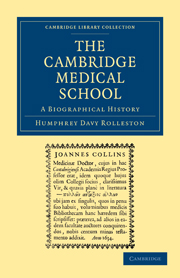Book contents
- Frontmatter
- Contents
- List of Plates
- Preface
- I The Medical School
- II Department of Anatomy
- III Department of Physiology
- IV Department of Biochemistry
- V Department of Experimental Psychology
- VI Department of Pathology
- VII Department of the Quick Chair of Biology
- VIII The Regius Chair of Physic
- IX John Caius
- X The Downing Chair of Medicine
- XI The Linacre Lectureship in Physic
- XII The Chair of Surgery
- Index of Persons
- Index of Subjects
- Plate section
X - The Downing Chair of Medicine
Published online by Cambridge University Press: 07 September 2010
- Frontmatter
- Contents
- List of Plates
- Preface
- I The Medical School
- II Department of Anatomy
- III Department of Physiology
- IV Department of Biochemistry
- V Department of Experimental Psychology
- VI Department of Pathology
- VII Department of the Quick Chair of Biology
- VIII The Regius Chair of Physic
- IX John Caius
- X The Downing Chair of Medicine
- XI The Linacre Lectureship in Physic
- XII The Chair of Surgery
- Index of Persons
- Index of Subjects
- Plate section
Summary
SIR George Downing (1684–1749), Bart., K.C.B., of Gamlingay, by his will dated December 20, 1717, left his property in Cambridgeshire, Bedfordshire, and Suffolk to trustees who in default of certain issue were directed to found Downing's (sic) College. His cousin Sir Jacob Garret (or Garrard) Downing, on whom the estates devolved, died without issue in 1764, and after more than thirty years' litigation the foundation of the college was recommended by the Privy Council on September 22, 1800. The college charter provided for two professorships—one of the Laws of England and the other of Medicine—as part of the college; these were filled up some years before the foundation stone of the college was laid on May 18, 1807.
On February 27, 1882, a Statute approved by the Queen in Council provided that the professor should receive from the University £300 more annually than the amount received as a fellow from Downing College, but not including his lodge in the college or any equivalent for it. Under the Statutes promulgated by the Royal Commission dated 1925 Downing College was relieved of any financial responsibility for future Downing Professors. The 1926 Statutes of Downing provide that, when the finances of the college permit, a Downing Reader in Medicine shall be appointed for three years by the Governing Body. The Downing Professorship of Medicine was abolished after the death of J. B. Bradbury (1841–1930), who held the chair for thirty-six years.
- Type
- Chapter
- Information
- The Cambridge Medical SchoolA Biographical History, pp. 199 - 212Publisher: Cambridge University PressPrint publication year: 2009First published in: 1932

